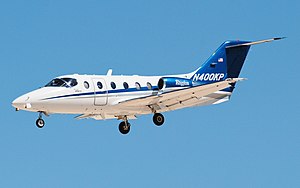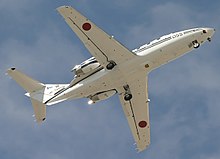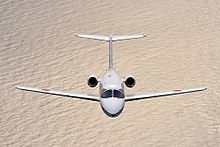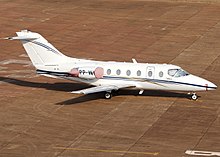| Hawker 400 | |
|---|---|
 Hawker 400XP Hawker 400XP | |
| General information | |
| Type | Business jet |
| National origin | Japan/United States |
| Manufacturer | Hawker Beechcraft |
| Status | Out of production, in service |
| Primary users | Flight Options Travel Management Co. |
| Number built | 951: 92 Mitsubishi MU-300, 859 Beechjet 400 |
| History | |
| Manufactured | 1978–2009 |
| First flight | August 29, 1978 (as Mitsubishi Diamond) |
| Variants | T-1 Jayhawk Nextant 400XT |
The Hawker 400 (also known as the Beechjet 400) is a light business jet. Initially designed and built by Mitsubishi, it has been further developed and updated by the Beech Aircraft Company, now part of Textron Aviation. A military version, the T-1 Jayhawk was also produced. In total, over 900 Hawker 400s have been delivered. In 2017, Hawker began to offer a manufacturer supported upgrade package known as the Hawker 400XPR. The new modifications are intended to reduce fuel consumption and improve range.
Design

The Hawker 400 is a small, low-winged twin-turbofan aircraft of all metal construction, flown by a crew of two pilots and accommodating eight passengers in a pressurised cabin. Its wings use a computer-designed supercritical airfoil in order to minimise drag. Its two Pratt & Whitney Canada JT15D turbofans are mounted on the rear fuselage.
The 400 can fly 1,351 nmi (2,502 km) with four passengers, cruising at Mach 0.71–0.73, and most pilots are comfortable flying it over three hours, about 1,175 nmi (2,176 km) cruising at Mach 0.73–0.76. Typical missions are 1.5 to 2.0 hours with 400 kn (740 km/h) block speeds. It burns 1,500 lb (680 kg) of fuel the first hour, dropping to 1,100–1,200 lb (500–540 kg) for the second. Basic operating weights range from 11,000 to 11,100 lb (4,990 to 5,030 kg), full tanks payload is less than 500–600 lb (230–270 kg) with an average passenger load of three, however its full capacity is six passengers 1,100 nmi (2,000 km).
Development
The aircraft was originally designed as the Mitsubishi MU-300 Diamond, an all-new, all-jet development to complement and slot above the Mitsubishi MU-2 and provide Mitsubishi Heavy Industries with their top-of-the-line corporate aircraft model (hence the name "Diamond"). It first flew on August 29, 1978. Mitsubishi chose to certificate the Diamond in the United States under FAA Part 25 regulations for transport aircraft, but additional requirements introduced by the FAA after the crash of an American Airlines DC-10 airliner at Chicago resulted in significant delays in the certification process, with the required changes to the aircraft adding 600 lb (270 kg), and the aircraft not receiving its certification until November 6, 1981. Mitsubishi went on to produce 97 MU-300s, all of which were assembled by the company's United States subsidiary.
In 1985, Mitsubishi sold the rights and a number of unfinished airframes to Beechcraft, who began manufacturing it as their own model, initially re-designated as the Beechjet 400, certificated by the Federal Aviation Administration in May 1986. Raytheon/Beechcraft developed improvements for the 1990 400A for longer range, higher take-off weights, luxury appointments and offering an all-glass flight deck.
Beechcraft developed the T-1 Jayhawk version for the United States Air Force, used as a trainer for crew of large aircraft like tankers and strategic transports: 180 were delivered between 1992 and 1997. The Japan Air Self-Defense Force 400T trainer shares the T1-A Type certificate.
In 1993, Raytheon purchased the Hawker business jets from British Aerospace and renamed the Beechjet 400 as the Hawker 400 to include it in the line.
In 2003, Raytheon began to produce Hawker 400XP, which included: 200 lb (91 kg) gross weight increase, a nine passenger seating option, thrust reversers, TCAS II, and an emergency locator beacon.
In 2008, Hawker Beechcraft announced an improved Hawker 450XP including new, more fuel efficient Pratt & Whitney PW535Ds with 2,965 pounds of thrust each, but it was canceled in June 2009 due to poor economic conditions. In 2009, its unit cost was $7.4 million USD.
Nextant Aerospace re-manufactured Hawker 400XP as the Nextant 400XT, replacing the JT15Ds with Williams FJ44-3APs and adding new avionics and interior. It was FAA-certified in October 2011. Up to one-third of the 400A/400XP fleet could be retrofitted, enabling improved range, speed and fuel efficiency. It should keep their resale value to remain in economic service for another twenty to thirty years, like Falcon 20s reengined with TFE731s.
In 2012, Textron has first flown Hawker 400XPR, which improves 4-pax range to 1,950 nmi (3,610 km; 2,240 mi), has better hot and high performance, and can climb to FL450 at max takeoff weight in 19 min. The conversion features new avionics, interior, winglets, and Williams FJ44-4A-32 engines. Hawker 400XPR was certified in 2016, and first fully configured Hawker 400XPR was delivered in July 2017; the upgrade can be performed in 12 weeks with a choice of Rockwell Collins Pro Line 4 to 21 or Garmin G5000 avionics.
Operational history

The type is used by many corporate and private users, it is also used by air-taxi and air charter companies.
In 2014, most were U.S. registered, a majority with single aircraft operators. Flight Options and Travel management co. were its largest operators as NetJets Europe has disposed of its fleet. The second highest concentration was in Mexico, then Brazil, the rest were scattered throughout the world. The USAF operated 178 T-1A Jayhawks. Charter and fractional operators fly at least 800 to 900 hours per year while most corporate operators fly 300 to 400 hours.
Variants



- Mitsubishi MU-300 Diamond I
- Initial model, ICAO designator MU30. Two prototypes and 89 production aircraft built, 56 in active use as of 2014.
- Mitsubishi MU-300-10 Diamond II
- Improved version of Diamond I; 11 built, all subsequently redesignated as Beechjet 400s.
- Beechcraft Model 400 Beechjet
- The Diamond II built after Beechcraft bought the MU-300 production rights from Mitsubishi. 54 built in addition to the original 11 Diamond IIs. ICAO designator BE40.
- Model 400A
- Upgraded model, initially produced as the Beechcraft Beechjet 400A, then Raytheon Beechjet 400A, then Raytheon Hawker 400XP, then Hawker Beechcraft Hawker 400XP. One prototype converted from Model 400 and 593 built as of the end of 2009. ICAO designator BE40.
- Model 400T
- Military version of the Model 400A, 180 built for the United States Air Force as the T-1 Jayhawk and 13 built for the Japan Air Self-Defense Force. In Japanese service they are referred to as T-400. ICAO designator BE40.
- Hawker 400XPR
- A factory engineered and supported upgrade of Hawker 400XP, first flown May 2012, and certified in 2016. The conversion features new avionics, interior, winglets, and Williams FJ44-4A-32 engines. The upgrade can be performed in 12 weeks with a choice of Rockwell Collins Pro Line 4 to 21 or Garmin G5000 avionics. Hawker 400XPR increases ferry range to 2160nmi, provides better hot and high performance, and 16-20% decrease in specific fuel consumption. 400XPR has ICAO designator BE4W, which is shared with Nextant 400XT, a competing upgrade of Hawker 400 made by Nextant Aerospace.
Specifications (Hawker 400XPR)
Data from Brassey's World Aircraft & Systems Directory 1999/2000, Hawker 400XPR Product Analysis
General characteristics
- Crew: 2 pilots
- Capacity: 7–9 passengers, 5,600 lb (2,500 kg) useful load
- Length: 48 ft 5 in (14.76 m)
- Wingspan: 43 ft 10 in (13.36 m)
- Height: 13 ft 11 in (4.24 m)
- Empty weight: 10,500 lb (4,763 kg)
- Max takeoff weight: 16,300 lb (7,394 kg)
- Pressurization: 9.1 psi (0.63 bar)
- Cabin height: 4.75 ft (1.45 m)
- Cabin width: 4.92 ft (1.50 m)
- Powerplant: 2 × Williams International FJ44-4A-32 turbofan, 3,200 lbf (14 kN) thrust each
Performance
- Maximum speed: 468 kn (539 mph, 866 km/h) (Mach 0.78 MMO)
- Cruise speed: 447 kn (514 mph, 828 km/h) High Speed Cruise, at FL450
- Stall speed: 92 kn (106 mph, 171 km/h) (full flaps)
- Range: 2,160 nmi (2,490 mi, 4,000 km) at 45,000 ft (13,700 m)
- Service ceiling: 45,000 ft (13,700 m)
- Fuel burn at high-speed cruise: 913 lb/h (414 kg/h) at 447 kn TAS at FL450
- Fuel burn at long-range cruise: 761 lb/h (345 kg/h) at 425 kn TAS at FL450
See also
Related development
Aircraft of comparable role, configuration, and era
- Beechcraft Premier I
- Cessna Citation II/V
- Cessna CitationJet CJ3/CJ4
- Dassault Falcon 10
- Embraer Phenom 300
- Learjet 25/31/35
Related lists
References
- ^ Fred George (December 10, 2014). "Operators Survey: Beechjet 400A/Hawker 400XP/Nextant 400XT". Business & Commercial Aviation.
- "Mitsubishi MU-300 production list". rzjets.
- "Beech 400 Beechjet production list". rzjets.
- Taylor, John W.R. (editor). Jane's All The World's Aircraft 1988–89. Coulsdon, UK: Jane's Defence Data, 1988. ISBN 0-7106-0867-5, pp. 339–340.
- Whitaker, Richard. "Diamond 1:Mitsubishi's first business jet". Flight International, July 18, 1981, pp. 163–167.
- Mitsubishi MU-300 Diamond, airliners.net
- Field, Hugh and Hurst, Mike. "The Great St Louis Meeting". Flight International, September 30, 1978, pp. 1261–1266.
- Shackleton 1983, p. 34
- Taylor 1982, p. 426
- Aviastar: Mitsubishi MU-300 / Diamond
- ^ FAA Type Certificate Number A16SW (Hawker Beechcraft Model 400 series), Revision 25 Archived December 28, 2016, at the Wayback Machine retrieved March 19, 2010
- Robert A. Searles (December 5, 2012). "QUICK LOOK: BEECHJET 400A. WICHITA BORN AND BRED--WITH A LOT OF DIFFERENT PARENTS". AOPA.
- "Hawker Beechcraft Introduces the Next-Generation Hawker 450XP Light Business Jet". Aviation Pros. October 13, 2008.
- "Hawker Beechcraft cancels 450XP jet". Archived from the original on February 12, 2009.
- 2009 Business Aircraft Comparison Charts, Business and Commercial Aviation magazine (online version) retrieved March 19, 2010
- "Nextant Aerospace Receives FAA Certification for the 400XT" (Press release). Nextant Aerospace. October 5, 2011. Archived from the original on September 13, 2017.
- ^ Chad Trautvetter (July 20, 2017). "Textron Delivers First Fully Configured Hawker 400XPR". Aviation International News.
- ^ "Hawker 400XPR Product Analysis" (PDF). Hawker Beechcraft Corporation.
- "A Score Of New Business Aircraft Are Planned". Aviation Week & Space Technology: 68. October 14, 2013.
- "Hawker 400XPR achieves FAA certification; first full upgraded 400XPR inducted" (Press release). Textron Aviation. September 15, 2016.
- ^ "Aircraft type designators" (PDF). International Civil Aviation Organization.
- FAA Type Certificate Number A14SW (Mitsubishi MU-300), Revision 9 Archived December 28, 2016, at the Wayback Machine retrieved March 19, 2010
- Hoyle, Craig (October 24, 2014), "Big in Japan: Tokyo's Top 10 aircraft projects", Flightglobal, Reed Business Information
- Hawker Beechcraft aircraft Serial Number Lists 1945 to present Archived March 7, 2010, at the Wayback Machine retrieved March 19, 2010.
- LAASdata list of Beechjet 400/Hawker 400/T-1/400T aircraft retrieved March 19, 2010. The list includes US and Japanese military variants but these have not been included in the total.
- "A Score Of New Business Aircraft Are Planned". Aviation Week & Space Technology: 68. October 14, 2013.
- "DOC 8643 - Aircraft Type Designators". ICAO.
- Kate Sarsfield (July 21, 2017). "Textron Aviation delivers first Hawker 400XPR upgrade". FlightGlobal.
- Taylor, Michael J.H. (editor). Brassey's World Aircraft & Systems Directory 1999/2000. London:Brassey's, 1999. ISBN 1-85753-245-7, pp. 521–522.
- Shackleton, Edwin A. (January 1983). "Diamond in the Sky". Aircraft Illustrated. Vol. 16, no. 1. pp. 34–35. ISSN 0002-2675.
- Taylor, John W. R., ed. (1982). Jane's All the World's Aircraft 1982–83. London: Jane's Yearbooks. ISBN 0-7106-0748-2.
External links
| Beechcraft, Raytheon and Hawker Beechcraft aircraft | |
|---|---|
| Model Numbers | |
| Names |
|
| Military designations | |
| Drones | |
| Hawker business jets | |
| Mitsubishi aircraft | |||||||||||||||||||||
|---|---|---|---|---|---|---|---|---|---|---|---|---|---|---|---|---|---|---|---|---|---|
| Company designations | |||||||||||||||||||||
| Imperial Japanese Army early designations | |||||||||||||||||||||
| Imperial Japanese Army short designations | |||||||||||||||||||||
| Imperial Japanese Navy short designations |
| ||||||||||||||||||||
| World War II Allied reporting names | |||||||||||||||||||||
| Japanese Self-Defense Force designations | |||||||||||||||||||||
| Company divisions |
| ||||||||||||||||||||